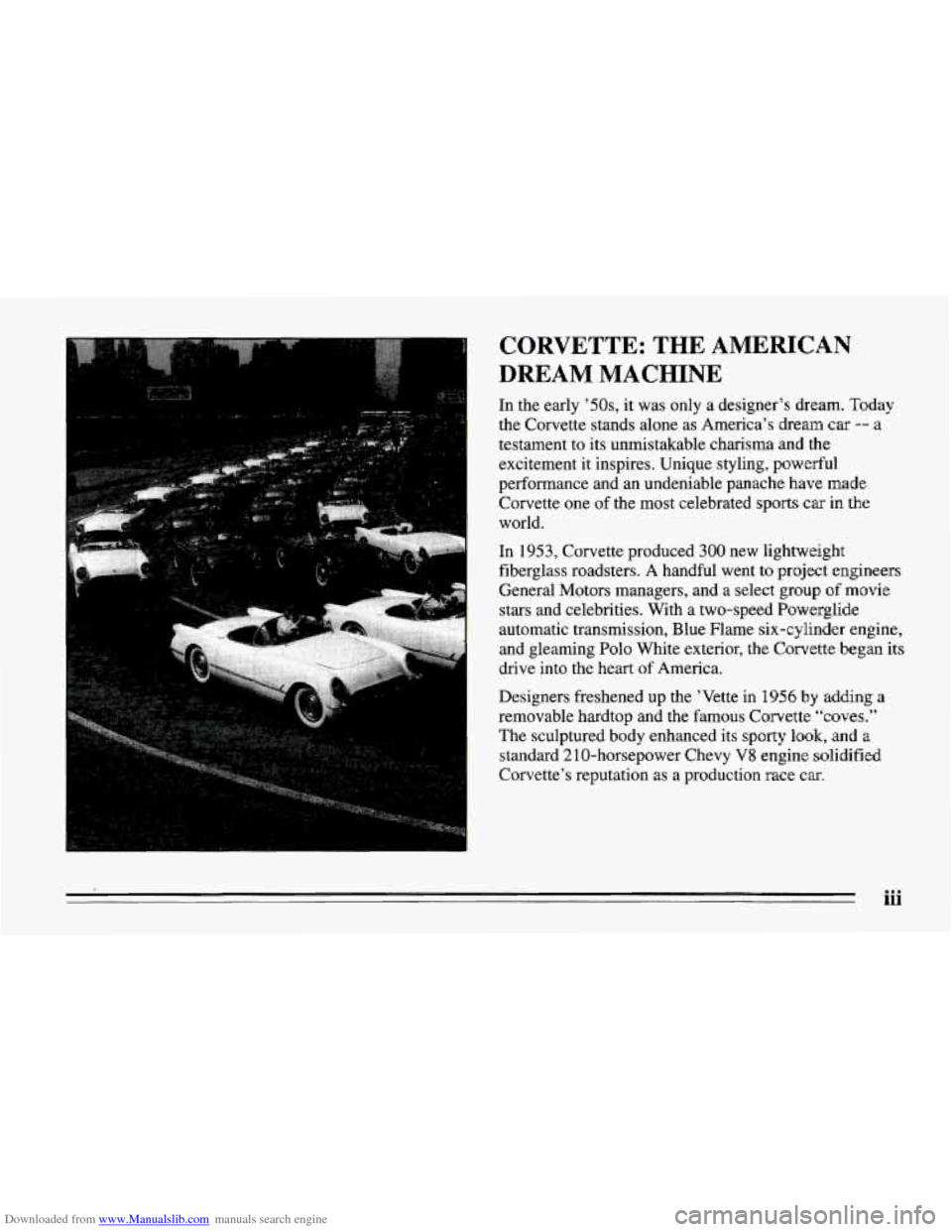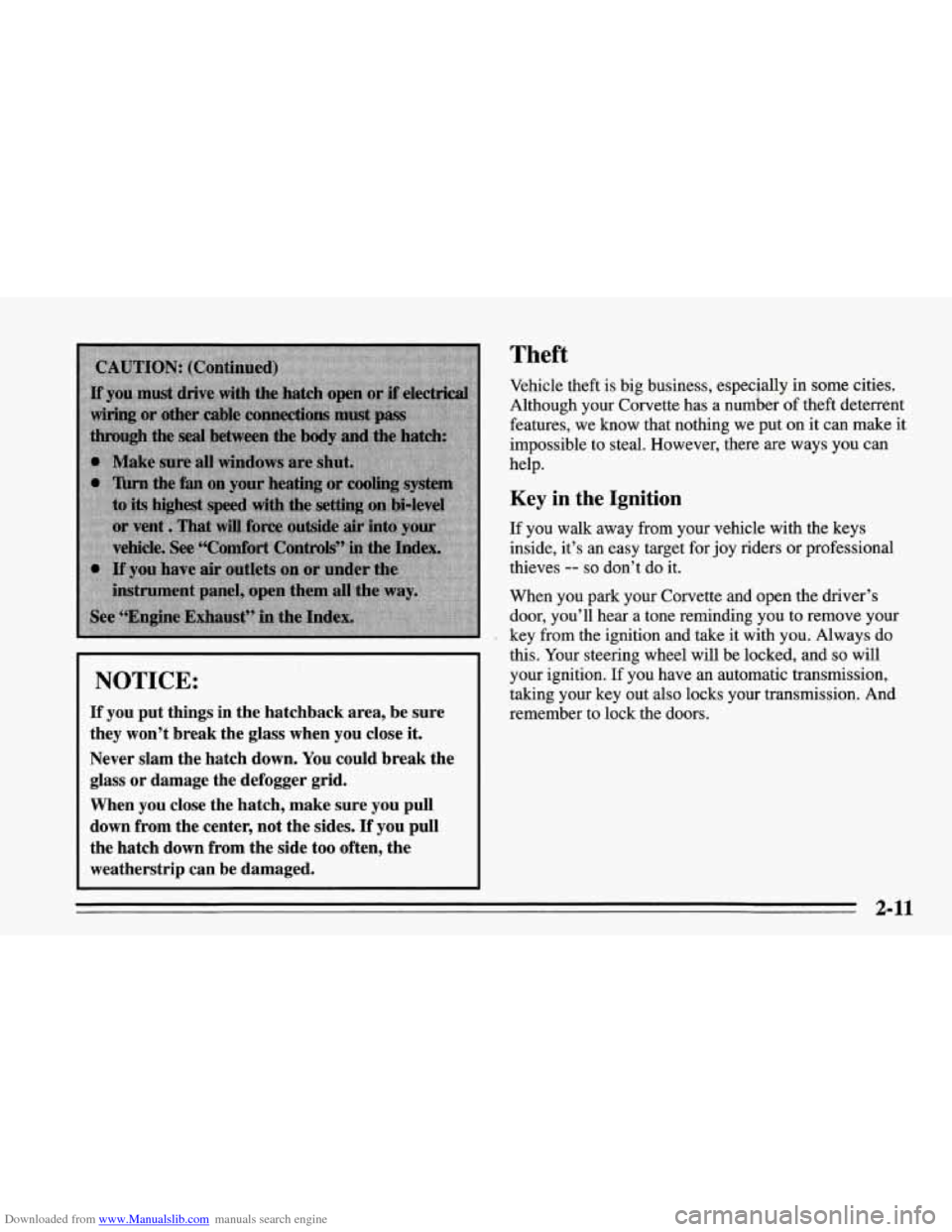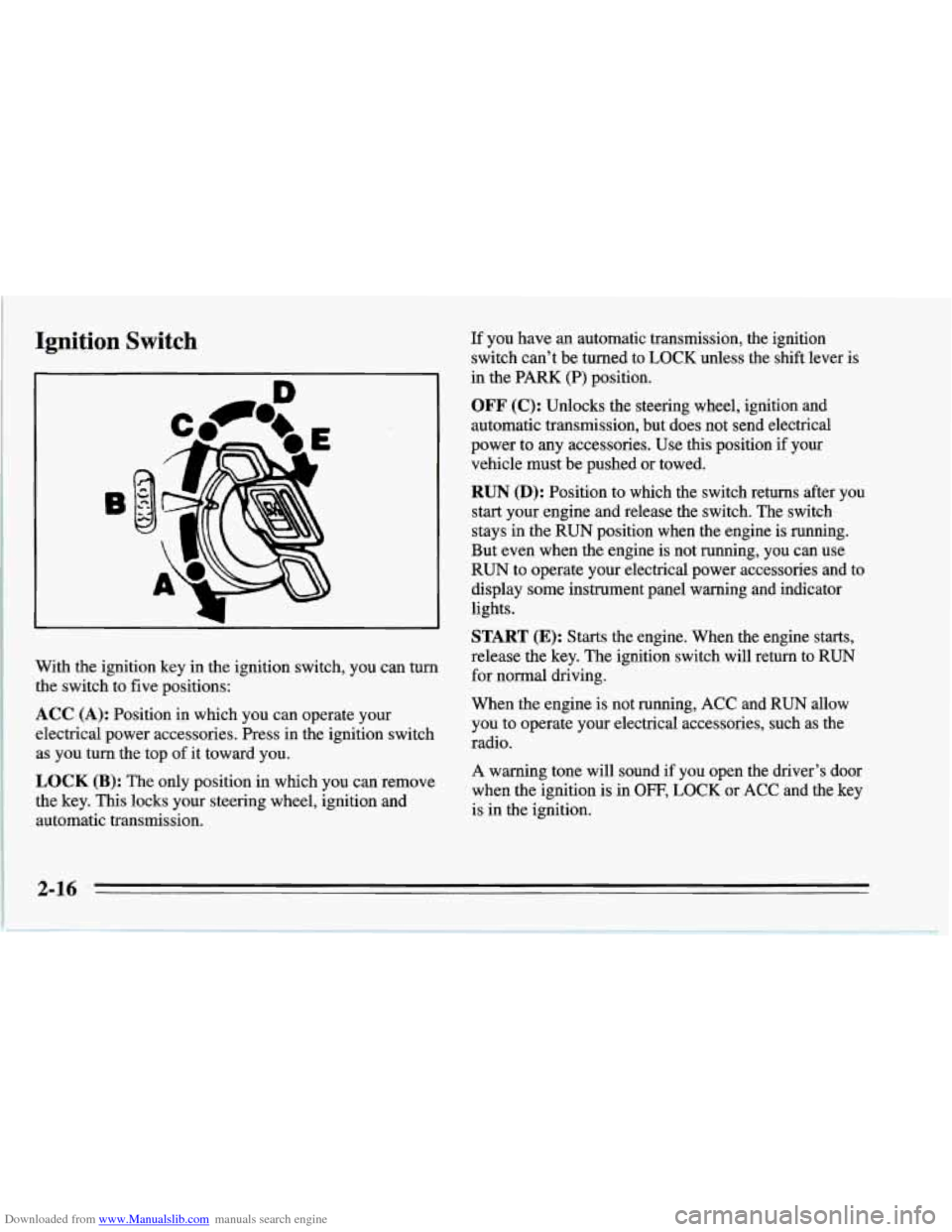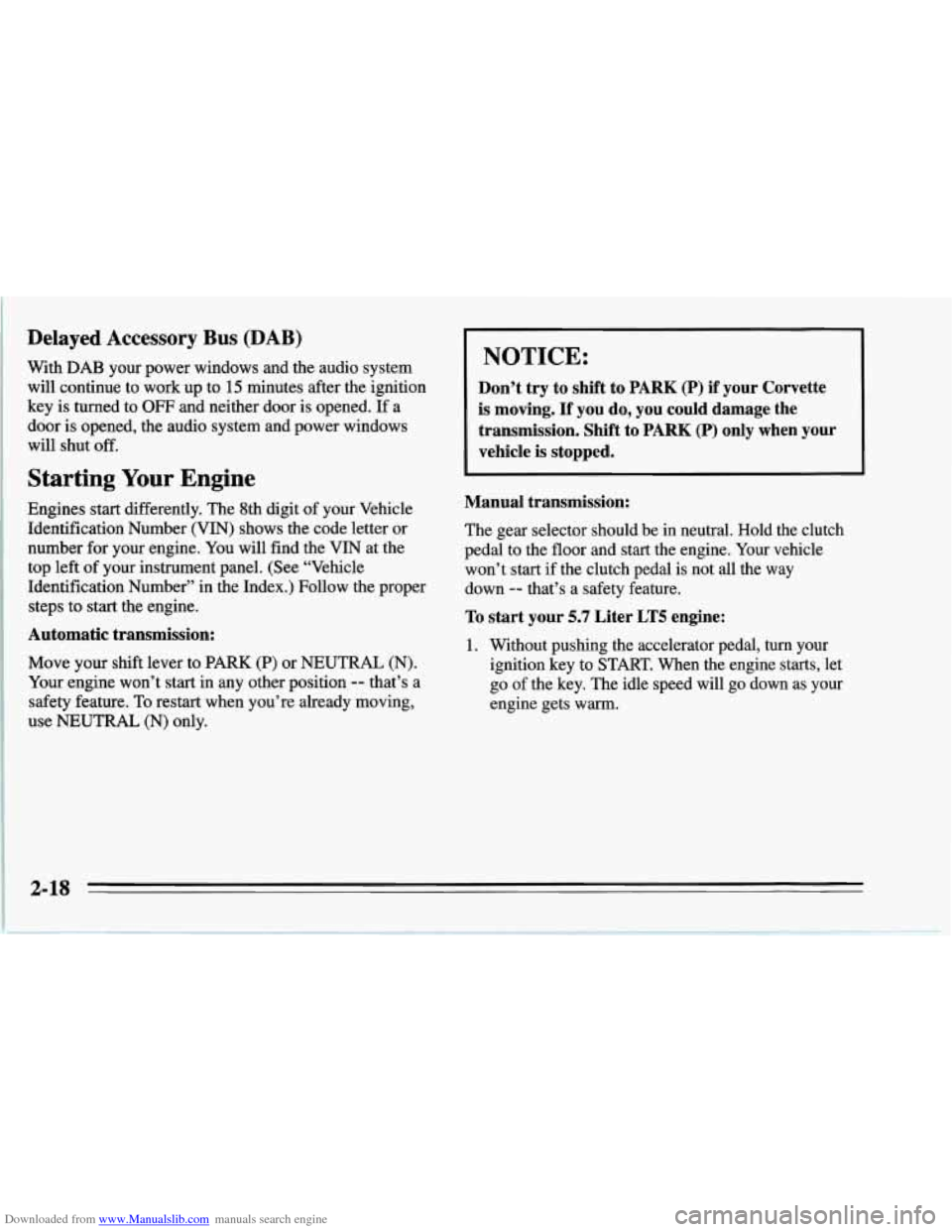Page 4 of 386

Downloaded from www.Manualslib.com manuals search engine CORVETTE: THE AMERICAN
DREAM MACHINE
In the early OS, it was only a designer’s dream. Today
the Corvette stands alone as America’s dream car
-- a
testament to its unmistakable charisma and the
excitement it inspires. Unique styling, powerful
performance and an undeniable panache
have made
Corvette one of the most celebrated sports car in the
world.
In
1953, Corvette produced 300 new lightweight
fiberglass roadsters. A handful went to project engineers
General Motors managers, and
a select group of movie
stars and celebrities. With a two-speed Powerglide
automatic transmission, Blue Flame six-cylinder engine,
and gleaming Polo White exterior,
the Corvette began its
drive into the heart of America.
Designers freshened up the ’Vette
in 1956 by adding a
removable hardtop and the famous Corvette “coves.”
The sculptured body enhanced its sporty look, and a
standard 2 1 0-horsepower Chevy V8 engine solidified
Corvette’s reputation as a production race car.
iii
Page 52 of 386
Downloaded from www.Manualslib.com manuals search engine To replace your battery: Remote Hatch Release
1.
2.
3.
4.
5.
Insert a screwdriver in the slot on the back of the
transmitter and gently pry apart the front and back.
Gently pry the battery out of the transmitter using the
screwdriver.
Put the new battery in the transmitter, positive
(+)
side up. Use a Duracell@ battery, type DL2450, or
equivalent.
Put the two halves back together. Make sure the
halves are together tightly
so water won’t get in.
Test the transmitter. Press the
switch in your center console to unlock the
hatch from inside your vehicle. If you have an automatic
transmission, your shift lever must be in
PARK (P) or
NEUTRAL (N) to use the switch. If you have a manual
transmission, you must set the parking brake before you
can use the switch when the vehicle
is running. If you
have a manual transmission and the vehicle is not
running, you may use the switch in any gear.
2-9
Page 54 of 386

Downloaded from www.Manualslib.com manuals search engine I NOTICE:
If you put things in the hatchback area, be sure
they won’t break the glass when you close
it.
Never slam the hatch down. You could break the
glass or damage the defogger grid.
When you close the hatch, make sure you pull
down from the center, not the sides.
If you pull
the hatch down from the side too often, the
weatherstrip can be damaged.
Theft
Vehicle theft is big business, especially in some cities.
Although your Corvette has a number of theft deterrent
features, we know that nothing we put on it can make it
impossible to steal. However, there
are ways you can
help.
Key in the Ignition
If you walk away from your vehicle with the keys
inside, it’s an easy target for joy riders
or professional
thieves
-- so don’t do it.
When you park your Corvette and open the driver’s
door, you’ll hear a tone reminding
you to remove your
key from the ignition and take it with
you. Always do
this. Your steering wheel will be locked, and
so will
your ignition. If you have an automatic transmission,
taking your key out also locks your transmission. And
remember to lock the doors.
3 11
Page 59 of 386

Downloaded from www.Manualslib.com manuals search engine Ignition Switch
With the ignition key in the ignition switch, you can turn
the switch to five positions:
ACC (A): Position in which you can operate your
electrical power accessories. Press in the ignition switch as you turn the top of it toward you.
LOCK (B): The only position in which you can remove
the key.
This locks your steering wheel, ignition and
automatic transmission. If
you have an automatic transmission, the ignition
switch can’t be turned to LOCK unless the shift lever is
in the PARK (P) position.
OFF (C): Unlocks the steering wheel, ignition and
automatic transmission, but does not send electrical
power to any accessories. Use this position
if your
vehicle. must be pushed or towed.
RUN (D): Position to which the switch returns after you
start your engine and release the switch. The switch
stays in the
RUN position when the engine is running.
But even when the engine is not running, you can use
RUN to operate your electrical power accessories and to
display some instrument panel warning and indicator
lights.
START (E): Starts the engine. When the engine starts,
release
the key. The ignition switch will return to RUN
for normal driving.
When
the engine is not running, ACC and RUN allow
you to operate your electrical accessories, such as the
radio.
A warning tone will sound if you open the driver’s door
when the ignition
is in OFF, LOCK or ACC and the key
is in the ignition.
Page 61 of 386

Downloaded from www.Manualslib.com manuals search engine Delayed Accessory Bus (DAB)
With DAB your power windows and the audio system
will continue to work up to 15 minutes after the ignition
key
is turned to OFF and neither door is opened. If a
door is opened, the audio system and power windows
will shut
off.
Starting Your Engine
Engines start differently. The 8th digit of your Vehicle
Identification Number
(VIN) shows the code letter or
number for your engine. You will find the
VIN at the
top left of your instrument panel. (See “Vehicle
Identification Number” in the Index.) Follow the proper
steps to
start the engine.
Automatic transmission:
Move your shift lever to PARK (P) or NEUTRAL (N).
Your engine won’t start in any other position
-- that’s a
safety feature. To restart when you’re already moving,
use
NEUTRAL (N) only.
NOTICE:
Don’t try to shift to PARK (P) if your Corvette
is moving.
If you do, you could damage the
transmission. Shift
to PARK (P) only when your
vehicle is stopped.
Manual transmission:
The gear selector should be in neutral. Hold the clutch
pedal to the floor and start the engine. Your vehicle
won’t start if the clutch pedal is not all the way
down
-- that’s a safety feature.
To start your 5.7 Liter LT5 engine:
1. Without pushing the accelerator pedal, turn your
ignition key to START. When the engine starts, let
go of the key. The idle speed will go down as your
engine gets warm.
Page 67 of 386
Downloaded from www.Manualslib.com manuals search engine I NOTICE:
After you’ve used the coolant heater, be sure to store the cord
as it was before to keep it away
from moving engine parts. If you don’t, it could
be damaged.
How long should you keep the coolant heater plugged
in? The answer depends on the weather, the kind
of oil
you have, and some other things. Instead
of trying to list
everything here, we ask that you contact your Chevrolet
dealer in the area where you’ll be parking your vehicle.
The dealer can give you the best advice for that
particular area.
Automatic Transmission
There are several different positions for your shift lever.
PARK (P): This locks your rear wheels. It’s the best
position
to use when you start your engine because your
vehicle can’t move easily.
2-24
Page 69 of 386
Downloaded from www.Manualslib.com manuals search engine NEUTRAL (N): In this position, your engine doesn’t
connect with the wheels.
To restart when you’re
already moving, use
NEUTRAL (N) only. Also, use
NEUTRAL (N) when your vehicle is being towed.
I NOTICE:
I
Damage to your transmission caused by shifting
out of
PARK (P) or NEUTRAL (N) with the
engine racing isn’t covered
by your warranty.
AUTOMATIC OVERDRIVE (0): This position is for
normal driving. If you need more power for passing, and
you’re:
Going less than about 35 mph (56 km/h), push your
accelerator pedal about halfway down.
Going about 35 mph (56 km/h) or more, push the
accelerator all
the way down.
You’ll shift down to the next gear and have more power.
DRIVE 0): This is like AUTOMATIC OVERDRIVE (@),
but you never go into overdrive.
Here
are some times you might choose DFUVE (D)
instead of AUTOMATIC OVERDRIVE
(0):
0 When driving on hilly, winding roads
0 When going down a steep hill
2-26
Page 76 of 386
Downloaded from www.Manualslib.com manuals search engine Shifting Into PARK (P)
(Automatic Transmission Models Only)
I
1. Hold the brake pedal down with your right foot and
set the parking brake.
holding in the button on the lever and pushing the
lever
all the way toward the front of your vehicle.
2. Move the shift lever into the PARK (P) position by
3. Move the ignition key to LOCK.
4. Remove the key and take it with you. If you can
walk away from your vehicle with the ignition key in
your hand, your vehicle
is in PARK (P).
2-33